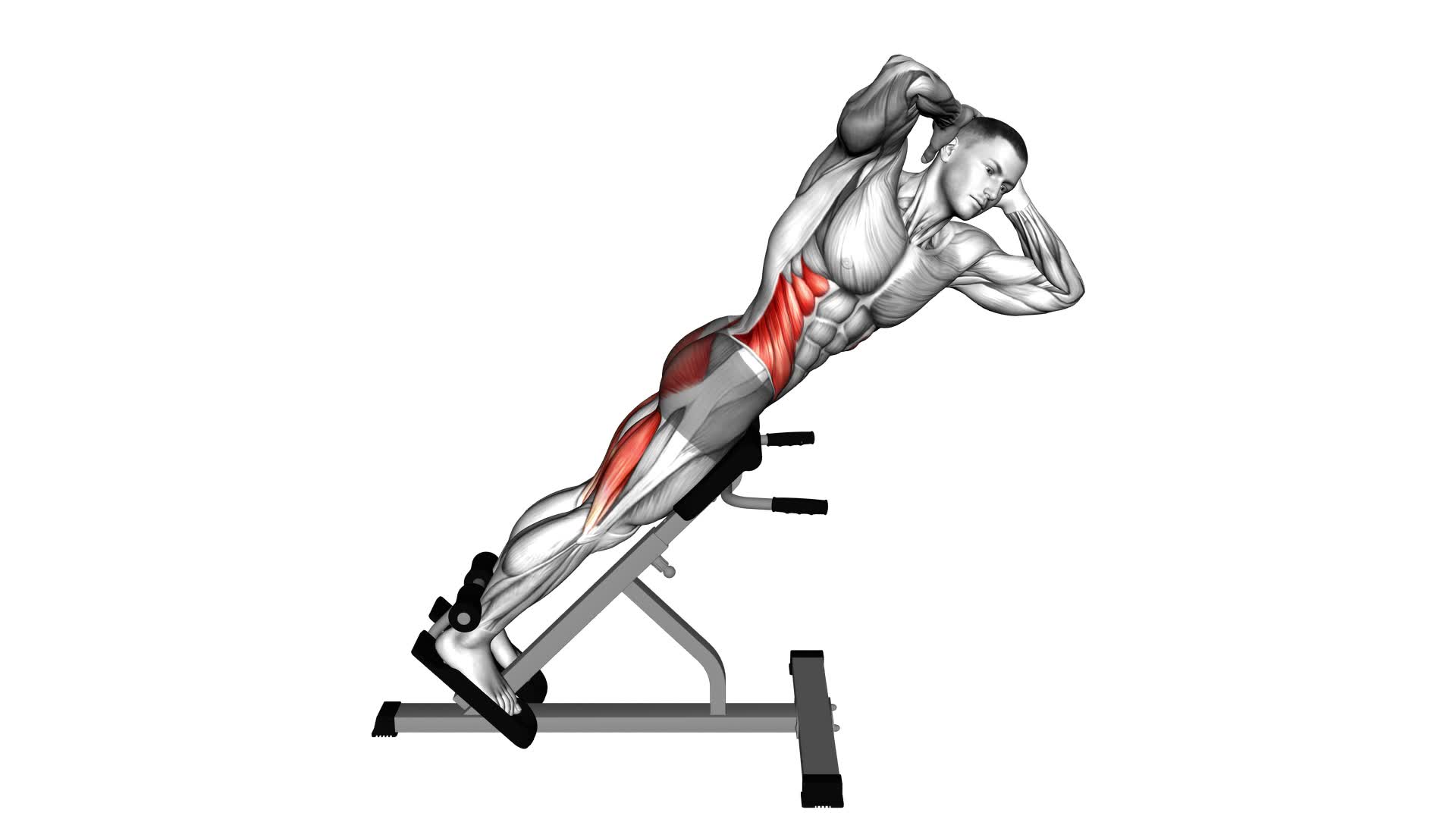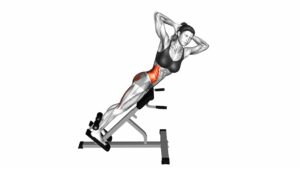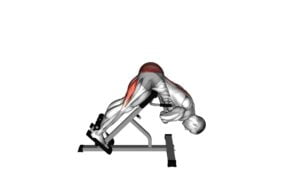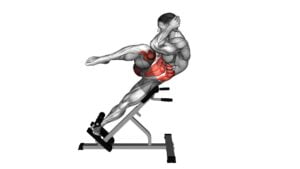45 Degree Twisting Hyperextension (Male) – Video Exercise Guide & Tips

Are you looking for a challenging exercise to target your core and back muscles? Look no further than the 45 Degree Twisting Hyperextension.
Watch This Exercise Video
This video exercise guide and tips will show you the proper form and technique to maximize your workout. Whether you're a beginner or an advanced athlete, there are modifications available for everyone.
Learn the benefits of this exercise and avoid common mistakes to get the most out of your routine.
Let's get started!
Key Takeaways
- Targets core muscles including abdominals, obliques, and lower back
- Improves core strength and stability
- Prevents lower back injuries
- Increases flexibility of the lower back
Benefits of the 45 Degree Twisting Hyperextension
You will experience several benefits when performing the 45 degree twisting hyperextension exercise. This exercise is highly effective in improving core strength and preventing lower back injuries.
Firstly, the twisting hyperextension targets your core muscles, including the abdominals, obliques, and lower back. By engaging these muscles, you can improve their strength and stability, leading to better posture and overall body balance.
Secondly, this exercise helps prevent lower back injuries. The twisting motion helps to strengthen the muscles that support the spine, reducing the risk of strains and sprains. Additionally, the hyperextension movement stretches the lower back, increasing its flexibility and reducing the likelihood of tightness and discomfort.
Furthermore, the 45 degree twisting hyperextension exercise can help enhance your athletic performance. A strong core is essential for generating power and transferring energy during sports activities. By strengthening your core, you can improve your performance in activities such as running, jumping, and throwing.
Proper Form and Technique for the Exercise
Maintaining proper form and technique is crucial when performing the 45 degree twisting hyperextension exercise. To ensure you get the most out of this exercise and minimize the risk of injury, it's important to focus on your form throughout the movement. One common error to avoid is using momentum to swing your body up instead of relying on your core and lower back muscles. This not only reduces the effectiveness of the exercise but also increases the risk of strain or injury. Another common mistake is rounding your back during the movement. To prevent this, engage your core and keep your back straight throughout the exercise.
There are also variations of the 45 degree twisting hyperextension that you can incorporate into your routine to target different muscle groups. One variation is the weighted hyperextension, where you hold a weight plate against your chest or at your sides to increase the resistance. This variation can help to further strengthen your lower back and core muscles. Another variation is the single-leg hyperextension, where you perform the exercise with one leg lifted off the ground. This variation adds an element of balance and stability, engaging additional muscles in your lower body.
Tips for Maximizing Your Workout
To optimize your workout, it's important to incorporate these tips into your routine.
One way to maximize intensity is by incorporating variations into your exercises. By adding variations, you challenge different muscles and prevent your body from adapting to the same routine. For example, if you usually do standard push-ups, try incorporating incline or decline push-ups to target different muscle groups.
Another tip is to increase the intensity of your workouts by incorporating interval training. This involves alternating between high-intensity exercises and periods of rest or lower intensity. Interval training has been shown to increase calorie burn and improve cardiovascular fitness.
Additionally, make sure to prioritize proper form and technique. This not only helps prevent injuries but also ensures that you're effectively targeting the intended muscles.
Lastly, don't forget to listen to your body and give yourself enough time to recover. Pushing yourself too hard without proper rest can lead to overtraining and hinder your progress.
Modifications for Beginners and Advanced Athletes
Beginners and advanced athletes can modify the Degree Twisting Hyperextension exercise to suit their fitness levels and goals. Whether you're just starting out or looking to challenge yourself, here are some modifications you can make:
- Beginner Modifications:
- Start with a smaller range of motion: If you find it difficult to fully extend your back and twist, begin by performing the exercise with a smaller range of motion. Gradually increase the range as you become more comfortable and stronger.
- Use a stability ball: Place a stability ball under your hips for added support and stability. This can help beginners maintain proper form and reduce strain on the lower back.
- Perform the exercise without weights: If you're new to this exercise, it's advisable to start without any additional weights. Focus on mastering the movement and building core strength before adding resistance.
- Advanced Modifications:
- Increase the range of motion: Once you have mastered the basic movement, you can challenge yourself by increasing the range of motion. Aim to fully extend your back and twist as far as you can comfortably go.
- Add resistance: To make the exercise more challenging, you can hold a weight plate or dumbbell against your chest. This will engage your muscles more and help you build strength and endurance.
- Perform the exercise on an unstable surface: Try performing the Degree Twisting Hyperextension on a wobble board or Bosu ball. This will further engage your core muscles and improve balance and stability.
By modifying the Degree Twisting Hyperextension exercise, you can tailor it to your fitness level and continue to progress.
Now, let's discuss some common mistakes to avoid during the exercise.
Common Mistakes to Avoid During the Exercise
One common mistake to avoid during the exercise is improper form. Proper technique is crucial for preventing injuries and maximizing the effectiveness of the degree twisting hyperextension.
One of the most common mistakes is arching the back excessively. This puts unnecessary strain on the lower back and can lead to discomfort or even injury. To avoid this, focus on maintaining a neutral spine throughout the exercise.
Another common mistake is using momentum to perform the movement. It's important to remember that this exercise is meant to be done slowly and controlled. Using momentum not only reduces the effectiveness of the exercise, but it also increases the risk of injury. To avoid this mistake, concentrate on using your core muscles to initiate and control the movement.
Lastly, another mistake to avoid is neglecting proper breathing technique. Breathing plays a significant role in core stability and maintaining proper form. Remember to exhale as you extend your body and inhale as you return to the starting position.
Frequently Asked Questions
How Many Sets and Reps Should I Do for the 45 Degree Twisting Hyperextension Exercise?
To properly engage your core during the 45 degree twisting hyperextension exercise, it's important to focus on form. Avoid common mistakes like using momentum or arching your back.
As for sets and reps, it's recommended to start with 2-3 sets of 10-12 reps. Gradually increase the intensity and volume as you get stronger and more comfortable with the exercise.
Remember to always listen to your body and consult with a professional if needed.
Can I Perform the 45 Degree Twisting Hyperextension Exercise if I Have a Lower Back Injury?
If you have a lower back injury, it's important to be cautious when performing the 45 degree twisting hyperextension exercise. There may be alternatives that are more suitable for your condition.
It's recommended to consult with a healthcare professional or a qualified trainer who can provide guidance on exercises that can help strengthen your back without causing further harm.
Taking precautions and listening to your body is crucial to prevent exacerbating your injury.
Is It Necessary to Use Weights While Performing the 45 Degree Twisting Hyperextension Exercise?
When performing the 45 degree twisting hyperextension exercise, using weights isn't necessary, but it can offer additional benefits. Adding weights can increase the resistance and challenge your muscles even more.
However, if you're a beginner or have any limitations or injuries, it's important to modify the exercise accordingly. Always consult with a qualified fitness professional or your healthcare provider to ensure you're performing the exercise safely and effectively.
Can I Substitute the 45 Degree Twisting Hyperextension Exercise With Another Exercise That Targets the Same Muscle Group?
Yes, you can substitute the 45 degree twisting hyperextension exercise with alternative exercises that target the same muscle group.
There are various options available, such as the plank with rotation, bird dog, or standing side bends.
These exercises provide similar benefits and can be modified for beginners by starting with lighter weights or performing them without weights altogether.
Remember to consult with a fitness professional to ensure proper form and technique.
What Are Some Alternatives or Variations of the 45 Degree Twisting Hyperextension Exercise That I Can Incorporate Into My Workout Routine?
If you're looking for alternatives to the 45-degree twisting hyperextension exercise, there are a few options you can incorporate into your routine.
Some alternatives include Russian twists, seated medicine ball twists, and woodchoppers. These exercises target similar muscle groups and provide the benefits of twisting movements, such as core strength and rotational stability.
It's important to choose exercises that align with your fitness goals and abilities.
Conclusion
In conclusion, the 45 Degree Twisting Hyperextension is a beneficial exercise for both beginners and advanced athletes. By following proper form and technique, you can maximize your workout and avoid common mistakes.
This exercise targets the core muscles and helps improve flexibility and strength. Whether you're looking to enhance your athletic performance or simply stay fit, incorporating the 45 Degree Twisting Hyperextension into your routine can bring great results.

Author
Years ago, the spark of my life’s passion ignited in my mind the moment I stepped into the local gym for the first time. The inaugural bead of perspiration, the initial endeavor, the very first surge of endorphins, and a sense of pride that washed over me post-workout marked the beginning of my deep-seated interest in strength sports, fitness, and sports nutrition. This very curiosity blossomed rapidly into a profound fascination, propelling me to earn a Master’s degree in Physical Education from the Academy of Physical Education in Krakow, followed by a Sports Manager diploma from the Jagiellonian University. My journey of growth led me to gain more specialized qualifications, such as being a certified personal trainer with a focus on sports dietetics, a lifeguard, and an instructor for wellness and corrective gymnastics. Theoretical knowledge paired seamlessly with practical experience, reinforcing my belief that the transformation of individuals under my guidance was also a reflection of my personal growth. This belief holds true even today. Each day, I strive to push the boundaries and explore new realms. These realms gently elevate me to greater heights. The unique combination of passion for my field and the continuous quest for growth fuels my drive to break new ground.







